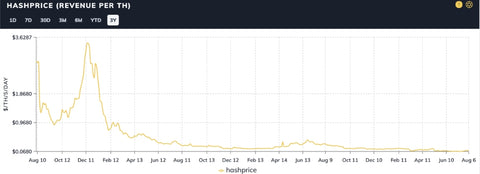The Bitcoin mining economy is formed by countless specific application computers competing with each other to ensure network security, which can extract an input triangle: revenue, operating costs, and capital expenditures.
By combining indicators such as internal rate of return (IRR), net present value (NPV), return on investment (ROI), and investment payback period, we can use these three major data to derive our views on the profitability of miners.
Although the days of using a BitContinent S9 mining machine to earn hundreds of dollars a day are over, for the top quarter of miners, they still have the opportunity to earn excess returns. With expertise in equipment procurement, low electricity bills, and advanced profit switching algorithms, miners can still obtain stable and considerable risk adjusted returns in an increasingly uncertain macro environment.
Increase income
In the input data triangle, miners believe that their income is largely predetermined. Miners generate computing power, and the value of computing power is largely beyond their control, as it is mainly based on the network of miners conducting mining. However, miners can increase their income through some leverage.
The miners decided where to monetize their computing power. In most cases, miners decide which currency they want to dig and which pool to sell their computing power to. Some platforms can provide higher profits than others, which means that miners can earn higher rewards by utilizing their computing power.

In addition, some coins will also have higher mining profits. Miners can use intelligent switching algorithms to improve their overall profitability. At any time, the profitability of different currencies will be influenced by persistent variables, such as network difficulty, currency prices, transaction costs, market depth, and other reasons.
For example, let's assume that today BTC mining may be more profitable than BCH and BSV. But tomorrow the most profitable person may become BCH again, and so on. The figure below shows the mining profitability fluctuation curve of Equihash algorithm currency within 12 hours.

Predicted revenue
Predicting revenue is the most difficult part when estimating the profitability of mining investments, as it requires you to make many estimates and assumptions yourself.
At present, the price of computing power is equivalent to approximately $0.10 TH/s per day. According to the indicators on the Hashrate Index, this is the weighted price currently paid by the mining pool to miners for computing power.

History shows that over time, the price of computing power continues to decline. As more computing power is added to the network, the value of existing computing power will be weakened. Since January 2016, the average daily decrease in computing power prices has been 0.06%. Miners can establish a universal model to predict computing power prices. The assumption underlying this model is that ASIC mining machines will only turn on when they are profitable. You can also incorporate pain thresholds for factors such as maintaining electricity investment, lock-in custody contracts, or money laundering. The amount of computing power (and corresponding difficulty) on the network depends on the price of computing power. And the amount of computing power determines the price of computing power. This is a circular calculation commonly used in models to predict debt repayment plans, which can be executed through Excel. Therefore, miners need to make assumptions about the computing power of new entrants, the computing power of each existing ASIC mining machine, electricity bills, as well as the miners' working capital (segmented by mining machine type), currency prices, transaction costs, etc. By utilizing this universal architecture to establish models, miners/investors will be able to predict the future price of their computing power.
operating costs
Undoubtedly, the most critical part of long-term success for miners is their electricity costs. ASIC mining machines consume a large amount of electricity, making the cost of a call a significant part of the miners' operating costs. The best operators can operate their facilities with a PUE (equipment energy consumption) lower than 1.05, which means that almost all the electricity consumed is used for the operation of the mining machine itself.
Even if the cost of electricity is only reduced by one cent, miners can save nearly $90000/MW in annual electricity costs. Miners flocked to areas offering low electricity bills in droves. According to most studies, the global average electricity price paid by miners ranges from 3 to 4 cents per kilowatt hour. Some of the most competitive operators in Sichuan, Kazakhstan, and Texas are currently able to receive electricity prices below 2 cents. In addition to electricity bills, miners also need to deploy durable ASIC management software, custom firmware, and appropriate cooling technology, which is crucial for reducing costs and energy consumption.

When there is a significant fluctuation in mining profits, miners with lower operating costs will not be affected. They can still purchase old mining machines at a very cheap price and still make a profit.
Capital expenditure
For all those who wish to enter the mining industry, the biggest entry barrier is the capital expenditure required to establish mines and purchase equipment.
For those miners who wish to do a big job directly, they can be managed through multiple mines around the world. But they still need to solve a crucial link, equipment procurement.
The primary and secondary markets of mining machines are very opaque. Manufacturers constantly change prices, specifications, and schedules on their websites. They also have internal struggles, such as BitContinent, which makes actual delivery full of uncertainty. The secondary market is conducted in chat groups, such as Telegram and WeChat, where there is no clear market pricing. The best operators in this field have experience dealing with manufacturers and ASIC distributors, which puts them in a favorable position when purchasing mining machines at a low cost. The experience and relationships required for ASIC procurement are obstacles for non industry professionals when entering the market. When miners purchase mining machines during the mining cycle, they must carefully consider. Sometimes, machines are cheap and return costs quickly. The Hashrate Index has a tracker for machine prices, which miners can use to determine the timing of purchasing mining machines during the mining cycle.

Profitability calculation
In any case, investors must consider potential risks and rewards before making decisions.
The internal rate of return (IRR) is the discount rate at which the net present value of all cash flows for a specific investment equals zero. IRR is a powerful tool for making capital investment decisions. Most importantly, IRR considers the time value of funds (opportunity cost). There are many investment opportunities both internally and externally in the mining industry. You can stop mining and buy Bitcoin, stocks, and even dollars. Each investment has a different risk profile, so naturally there are different return expectations. The higher the risk of investment, the higher the expected return. This is the so-called required rate of return (RRR).
Each miner has their own required rate of return. It must be determined at the individual level based on the individual situation of the miner. For experienced operators who have access to low electricity bills, high-quality ASIC procurement resources, and relatively cheap capital, their required return rate will be lower than that of newcomers to the industry.
We can also refer to other indicators, such as net present value, investment return rate, investment payback period, etc.
Mining income
In summary, if the operation is set up correctly and executed properly, the mining industry can still provide huge returns. Experienced operators will have an advantage in increasingly challenging environments.

